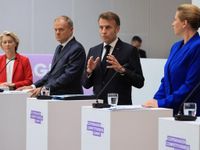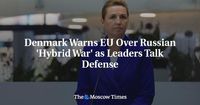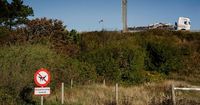Europe is facing what many leaders now openly call a new era of danger, as Danish Prime Minister Mette Frederiksen declared on October 1, 2025, that the continent is in the midst of a hybrid war waged by Russia. Speaking at a summit of European Union leaders in Copenhagen—a gathering marked by a tense atmosphere and unprecedented security—Frederiksen’s words signaled a collective reckoning with a threat that, until recently, many in Europe hoped could be contained at its eastern border.
“I hope that everybody recognizes now that there is a hybrid war and one day it’s Poland, the other day it’s Denmark, and next week it will probably be somewhere else that we see sabotage or we see drones flying,” Frederiksen told reporters, according to the Associated Press and NYPost. Her remarks echoed across the summit, resonating with a continent that, over the past month, has witnessed a spate of Russian drone incursions and airspace violations over Poland, Denmark, Estonia, and Romania. These incidents, experts warn, are not isolated provocations but part of a deliberate tactic to test NATO’s defenses and probe for weaknesses.
The urgency of the moment was underscored by the extraordinary measures taken in Copenhagen. Just days before the summit, unidentified drones forced the closure of the city’s airport, causing major disruptions and prompting authorities to install a special radar system to monitor the skies. France, Germany, the Netherlands, Sweden, and the United Kingdom sent aircraft, ships, and air defense systems to Denmark for the talks, a show of solidarity and a clear signal to Moscow that Europe is taking the threat seriously.
While Danish authorities have not publicly identified the perpetrators behind the drone incursions, Frederiksen left little room for doubt. “There is only one country that is willing to threaten us, and it is Russia, and therefore we need a very strong answer back,” she said, as reported by multiple outlets. Her call was not just for vigilance, but for concrete action: “I want us to rearm. I want us to buy more capabilities. I want us to innovate more, for example, on drones.”
Frederiksen’s warnings were echoed by other European leaders, each offering a slightly different perspective on how to respond to the mounting danger. French President Emmanuel Macron, attending the summit, urged both strength and restraint. “I think we all have to be very cautious because we are in a time of confrontation with a lot of hybridity,” Macron said. “This is why we have to be strong to deter any aggressions, but we have to remain very cautious and avoid any escalation.” Italian Prime Minister Giorgia Meloni added, “Despite everything, I think we have to think calmly. I think we shouldn’t respond to provocations. We have to equip ourselves, that certainly is true.”
Hybrid warfare, as defined by European leaders, is not limited to tanks and missiles. It encompasses cyberattacks, disinformation campaigns, sabotage, and the use of unmanned aerial vehicles (UAVs) to disrupt and intimidate. In the past week alone, drone sightings near Danish airports and military bases forced closures and heightened tensions. According to the BBC, Ukraine’s armed forces even dispatched a mission to Denmark for joint exercises, sharing expertise on how to counter Russian drone tactics—expertise honed over years of conflict in Ukraine.
European officials are now openly discussing the creation of a “drone wall”—a network of sensors and weapons along the continent’s border to detect, track, and neutralize UAVs entering European airspace. Finland’s Prime Minister Petteri Orpo voiced strong support for such a project, stating, “Russia will continue and we have to be ready, we have to strengthen our preparedness.” Kremlin spokesman Dmitry Peskov, however, dismissed the idea, telling reporters, “As history has shown, erecting walls is always a bad thing.”
The specter of a broader conflict looms large. Intelligence reports presented at the summit suggest that Russian President Vladimir Putin could mount another invasion elsewhere in Europe within three to five years—a warning that has jolted EU capitals into action. The timing is particularly fraught, as doubts swirl about the United States’ commitment to NATO under President Donald Trump, who has ruled out NATO membership for Ukraine, the country’s best available security guarantee.
Indeed, the events of September 2025 marked a turning point. On September 10, Russian drones breached Polish airspace, prompting NATO aircraft to intercept and shoot down several devices. It was the first direct encounter between NATO and Moscow since Russia’s full-scale invasion of Ukraine in February 2022. Days later, NATO jets escorted Russian warplanes out of Estonian airspace, further raising the stakes. In Romania, the defense ministry confirmed that a Russian drone had violated its airspace during an attack on Ukrainian infrastructure. Poland, meanwhile, said it had shot down Russian drones that crossed its border as Moscow launched a barrage against Ukraine.
These incidents have not only tested NATO’s readiness but have also sparked debate within the alliance about how to respond. Macron, in an interview with Germany’s Frankfurter Allgemeine Zeitung, suggested that NATO’s response would have to “go up a notch” in the face of new provocations, and did not rule out downing a Russian fighter jet if it were to breach European airspace. “In accordance with the doctrine of strategic ambiguity, I can tell you that nothing is ruled out,” he said.
Amid these warnings, not all defense experts agree on the immediacy of the threat. Some question whether Russia’s military, stretched by its ongoing war in Ukraine, is truly capable of mounting another large-scale invasion in the near future. Nevertheless, the prevailing mood among European leaders is one of grave concern. Frederiksen summed it up starkly: “When I look at Europe today, I think we are in the most difficult and dangerous situation since the end of the Second World War.”
As the summit continued, leaders also turned their attention to Ukraine. Discussions included proposals to use frozen Russian assets to support Ukraine’s war effort, as well as the country’s prospects for joining the EU. Ukrainian President Volodymyr Zelenskyy was expected to address the leaders by videolink, underscoring the interconnectedness of Ukraine’s fate with that of the wider continent.
The Copenhagen summit drew not only EU heads of state but also leaders from the United Kingdom, the Balkans, and Turkey, as part of the European Political Community (EPC). While critics have dismissed the EPC as a “talking shop” with few tangible results, the gravity of the current crisis lent new urgency to the discussions. Formal talks scheduled for October 2 were set to focus on security, trafficking, and migration—issues now inseparable from the broader challenge of defending Europe’s borders and way of life.
With warnings of Russian aggression ringing in their ears, Europe’s leaders left Copenhagen with a sobering mandate: rearm, innovate, and prepare for a future in which hybrid war is no longer a distant threat, but a present reality demanding unity, resilience, and resolve.


